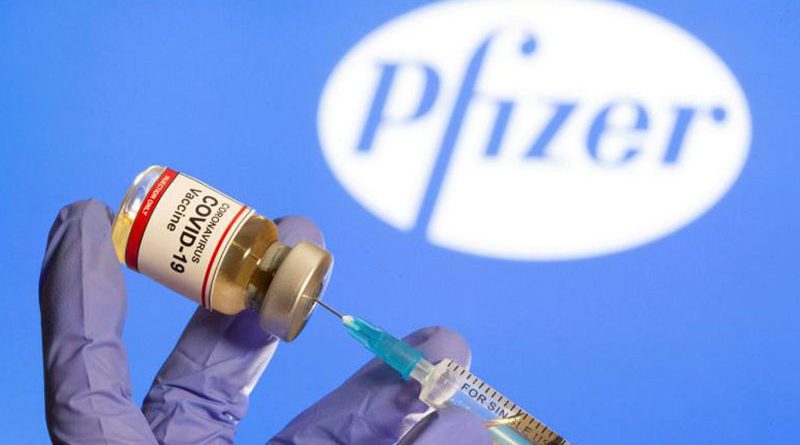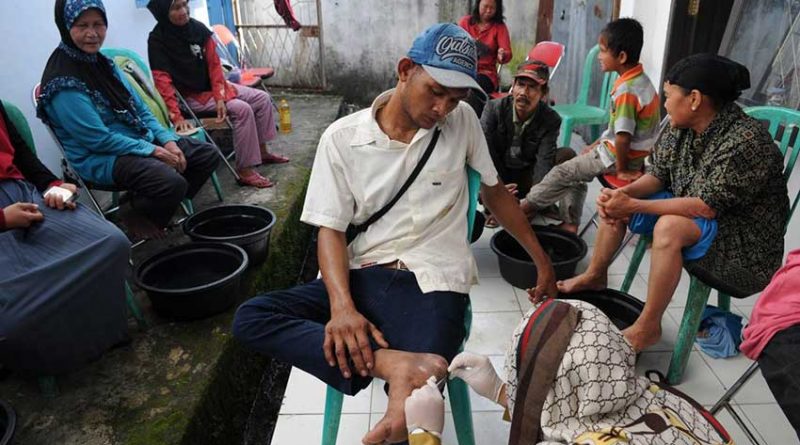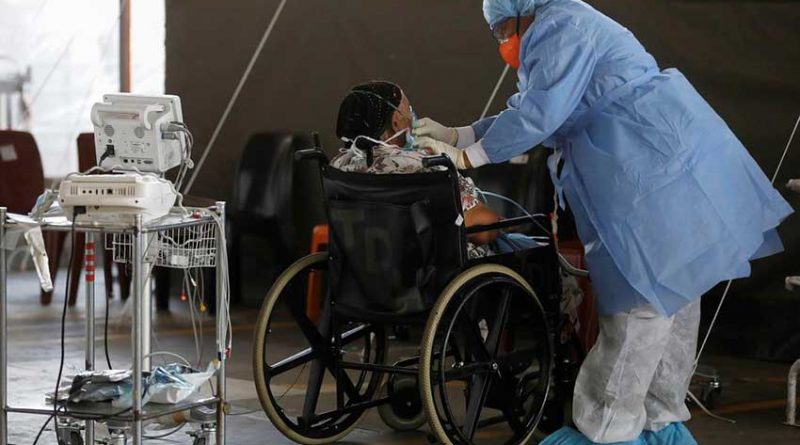THE Pfizer-BioNTech COVID-19 vaccine may be less able to protect against infection with a South African variant of the virus that has a worrying mutation, according to results of a British study released yesterday.
The preliminary data, which have yet to be peer-reviewed and involve a small number of patients, also suggest a significant proportion of people aged over 80 may not be sufficiently protected against new variants of the virus until they have had two doses of the vaccine, researchers leading the study said.
“Of particular concern … is the emergence of the E484K mutation (found in the South African variant), which so far has only been seen in a relatively small number of individuals,” said Ravi Gupta, a professor at Cambridge University’s Institute of Therapeutic Immunology & Infectious Disease, who co-led the study.
“Our work suggests the vaccine is likely to be less effective when dealing with this mutation.”
Britain and many other countries have begun rolling out the Pfizer-BioNTech vaccine to try to stem the spread of the pandemic disease.
While the highly effective vaccine is designed to be given in two doses around three weeks apart, Britain’s government has opted to extend that time gap to up to 12 weeks to try to swiftly reach as many people as possible with a first dose.
The study released on Tuesday used blood samples from 26 people who had received their first dose of the Pfizer vaccine three weeks previously to test whether the shot would protect against two variants of the SARS-CoV-2 virus – the UK variant, known as B1.1.7., and the South African variant, which has the E484K mutation.
When testing the blood serum samples, all but seven of the participants had levels of antibodies sufficiently high to neutralise the virus – that is, to protect against infection, the researchers said.
When the scientists added all the key mutations found in B1.1.7 variant, however, they found the efficacy of the vaccine was affected, with, on average, two-fold higher concentrations of antibody required to neutralise the virus.
When the E484K mutation was added, even greater levels of antibody were required for the virus to be neutralised – with an average of a 10-fold increase needed, the researchers said.
Dami Collier, who co-led the work, said the findings suggest “a significant proportion of people aged over 80 may not have developed protective neutralising antibodies against infection three weeks after their first dose of the vaccine.”
Clinical trial data released last week on two other COVID-19 vaccines – from Novavax and Johnson & Johnson – also found the South African coronavirus reduced their ability to protect against the disease.
FIRST, it was the neighbours who started avoiding Indonesian food hawker Titi Amaliyah. Then regular customers stopped buying her traditional noodle snacks when word spread that she had been diagnosed with leprosy.
Since her diagnosis last year, Amaliyah and her family have been dependent on her husband’s income from odd jobs, which has dwindled due to the coronavirus pandemic. With three children, they are struggling to put food on the table.
“It’s a mental burden for me and it affects my family’s income,” said Amaliyah, 44, who is being treated for the age-old disease that can be cured with a combination of drugs.
“I just want the red spots on my skin to disappear,” she told the Thomson Reuters Foundation by phone from Indonesia’s central Java island, looking to the days when she can be accepted by her close-knit community again.
Amaliyah is one of the thousands of Indonesians living with leprosy, a disease caused by bacteria spread through droplets from the nose and mouth that causes nerve damage and lesions on the skin.
It often carries a stigma that pushes sufferers to live on the margins of society, while fears of economic and social exclusion mean many do not get tested or treated.
Indonesia reported more than 17,000 new cases in 2019, the third-highest in the world after India and Brazil, according to the World Health Organization (WHO).
And as affected countries focus on combatting COVID-19, health experts fear leprosy is being pushed further to the margins.

TIME BOMB
Leprosy is one of the oldest known diseases, affecting the poorest and most marginalised communities.
Millions have been cured since 1981 with a multidrug therapy and the number of cases worldwide has plummeted from a total of 10-12 million in the mid-1980s to about 200,000 new cases each year now.
But it still exists in more than 100 countries, and millions live with its effects.
Leprosy is one of the neglected tropical diseases (NTDs) that affect more than 1.7 billion people in some of the world’s poorest countries.
These diseases disable and disfigure sufferers, often leaving them isolated and unable to earn a living, but they can be treated.
On Saturday, the WHO will mark World NTD Day after launching a roadmap setting out global targets to tackle 20 of the diseases including leprosy by 2030.
The roadmap comes amid concerns that the pandemic is hampering efforts to tackle NTDs like leprosy, which health advocates say could be a ticking health time bomb for Indonesia, a country of 270 million where access to healthcare was challenging even before.
“We believe there will be a large-scale transmission in the coming two to five years,” said Indonesian leprosy survivor Paulus Manek, who heads Permata, a charity helping sufferers.
Manek said local health facilities were overwhelmed, causing delays in accessing medicines, and COVID-19 movement restrictions had prevented his charity from operating. Indonesia has more than a million coronavirus cases.
“We’re not going all out to prevent leprosy, the contacts are not traced. Even though the government has good regulations in place, enforcement on the ground is patchy,” said Manek, 40.
Indonesia’s health ministry did not reply to a request for comment. The ministry said last year it was working to raise public awareness about leprosy and in September it launched online training for health workers to detect new cases.
NLR Indonesia, a non-profit organisation that works with Indonesia to eliminate leprosy, said officials had introduced solutions including prescribing medications for a longer period than the usual one month.
But it said detection of new cases in 34 districts it works in had fallen 40% in the first six months of last year compared to 2019, suggesting resources to trace and spot new patients had been shifted elsewhere.
“These are not just worries. If we compare the data… this shows the efforts have gone down last year although this is inevitable due to COVID-19,” said Asken Sinaga, NLR Indonesia’s executive director.
“We hope the government can keep its attention on leprosy despite its current priority on COVID-19.
“The awareness on leprosy is low in Indonesia and there is widespread stigma. Some doctors are not aware leprosy is still an issue in Indonesia and they don’t know how to diagnose it,” Sinaga added.

STIGMA AND MYTH
Yet Thoko Elphick-Pooley, director of the Uniting to Combat NTDs coalition, argues the global mobilisation against COVID-19 can provide the push needed to tackle diseases that have long been neglected.
“We can use the impetus we have now from COVID to deal with some of those diseases, like leprosy, which was around thousands of years ago and is still around,” she said.
“We get outraged by diseases that kill, but not by diseases that disable.”
The WHO declared leprosy was no longer a public health problem in 2000 when the number of cases fell to less than one in 10,000 people.
Transmission is believed to take place during the long incubation period, between three and five years on average, before the disease can be diagnosed. Leprosy symptoms can take up to 20 years to appear.
One way of stopping the disease from spreading is to trace all contacts of patients and give them preventative treatment.
But stigma and myths associated with leprosy that go back centuries can deter people from seeking treatment, leading to permanent disability.
“Late diagnosis leads to late treatment and more risk of developing disabilities,” said Liesbeth Mieras, head of the medical technical department at Netherlands-based non-profit NLR, which works in five countries to eliminate leprosy.
“The COVID-19 pandemic has diverted health staff to work solely on COVID-19 related activities, which has led to a substantial reduction in the number of new patients detected.”
Many affected by leprosy still bear the scars even after they are cured.
“For COVID, it is a disease inside your body, people cannot see it,” said Dasuki Hidayat, 40, who was cured of leprosy in 2000 but suffered permanent nerve damage to his hands.
“With leprosy, when people hear the name, they are still disgusted. The stigma towards leprosy is still very high.”
THE new COVID-19 variant identified in South Africa can evade the antibodies that attack it in treatments using blood plasma from previously recovered patients and may reduce the efficacy of the current line of vaccines, scientists have said.
Researchers are racing to establish whether the vaccines currently being rolled out across the globe are effective against the so-called 501Y.V2 variant, identified by South African genomics experts late last year in Nelson Mandela Bay.
“This lineage exhibits complete escape from three classes of therapeutically relevant monoclonal antibodies,” the team of scientists from three South African universities working with the National Institute for Communicable Diseases (NICD) wrote in a paper published in the bioRxiv journal.
“Furthermore, 501Y.V2 shows substantial or complete escape from neutralising antibodies in COVID-19 convalescent plasma,” they wrote, adding that their conclusions “highlight the prospect of reinfection … and may foreshadow reduced efficacy of current spike-based vaccines.”
The 501Y.V2 variant is 50% more infectious than previous ones, South African researchers said this week. It has already spread to at least 20 countries since being reported to the World Health Organisation in late December.
It is one of several new variants discovered in recent months, including others first found in England and Brazil.
The variant is the main driver of South Africa’s second wave of COVID-19 infections, which hit a new daily peak above 21,000 cases earlier this month, far above the first wave, before falling to about 12,000 a day.
Convalescent blood plasma from previous patients has not been shown to be effective when administered to severely ill patients requiring intensive care for COVID-19, but it is approved in several countries as an emergency measure.
British scientists and politicians have expressed concern that vaccines currently being deployed or in development could be less effective against the variant.
The paper said it remained to be seen how effective current vaccines were against 501Y.V2, which would only be determined by large-scale clinical trials. But results showed the need for new vaccines to be designed to tackle the evolving threat, it said.
Source – Thomson Reuters Foundation
MILLIONS of coronavirus vaccine doses secured by the African Union (AU) will be allocated according to countries’ population size, South African President Cyril Ramaphosa has announced.
Ramaphosa, who is the current AU chairman, said on Wednesday that vaccines from Pfizer, Johnson & Johnson and AstraZeneca would be available this year, but he did not specify how much each African country would get.
No African countries have begun large-scale coronavirus vaccination campaigns and the AU’s 270 million shots, if administered two per person, would still only cover around 10% of the continent’s 1.3 billion people.
“The Africa CDC has already worked out the allocations that each country will be able to get, and the allocation is going to be worked on the size of your population,” Ramaphosa said, referring to the AU’s Centres for Disease Control and Prevention.
The CDC did not respond to a request for further detail.
LOOKING TO CHINA
Its director John Nkengasong cautioned on Thursday that vaccines would not be a magic bullet for Africa as it would take time for them to be rolled out and a second wave of infections had not yet peaked.
The continent’s confirmed cases have passed 3.1 million, with more than 76,000 deaths, according to a Reuters tally.
Speaking to South African news website Eyewitness News and 702 radio, Ramaphosa also suggested that the AU would access vaccines from China. “China will also be part of that, although they will join later,” he said.
South Africa itself plans to access doses via three sources: the AU arrangement, the COVAX facility co-led by the World Health Organization, and direct deals with manufacturers.
“We have decided that we should have a multi-supplier process … we are already getting ready for the distribution (and) the vaccination programme,” he said.
South Africa has recorded the most coronavirus infections and deaths in Africa, at roughly 1.3 million and 36,000.
Source – The African Mirror




